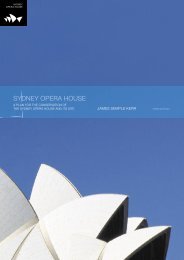nomination by the Government of Australia - Sydney Opera House
nomination by the Government of Australia - Sydney Opera House
nomination by the Government of Australia - Sydney Opera House
You also want an ePaper? Increase the reach of your titles
YUMPU automatically turns print PDFs into web optimized ePapers that Google loves.
3.36<br />
qualities and precise, geometric defi nition—was a clear<br />
departure from what went before him. Giedion claimed<br />
that, for Utzon, <strong>the</strong> machine is subordinated to <strong>the</strong><br />
creative process in a way that o<strong>the</strong>r modern architects<br />
had not previously accomplished (Giedion 1967: 694).<br />
Norberg-Schulz wrote a compelling argument for <strong>the</strong><br />
rightful place <strong>of</strong> Utzon in a line <strong>of</strong> great modern masters<br />
including Frank Lloyd Wright, Le Corbusier, Mies van<br />
der Rohe, Alvar Aalto and Louis Kahn. Utzon’s <strong>Sydney</strong><br />
<strong>Opera</strong> <strong>House</strong> represented an important contribution<br />
to <strong>the</strong> emergence <strong>of</strong> ‘a new monumentality’ and ‘new<br />
regionalism’ in modern architecture (Norberg-Schulz<br />
1996: 172).<br />
The poetic and environmental ambitions <strong>of</strong> <strong>the</strong> third<br />
generation are exemplifi ed in two masterpieces—<br />
Utzon’s <strong>Sydney</strong> <strong>Opera</strong> <strong>House</strong> and Le Corbusier’s<br />
Notre-Dame-du-Haut Chapel at Ronchamp (France<br />
1950–1955). Nei<strong>the</strong>r building can be separated from<br />
its outstanding landscape setting. In each case, <strong>the</strong><br />
outcome is a product <strong>of</strong> <strong>the</strong> timelessness <strong>of</strong> intense<br />
beauty, form and <strong>the</strong> meticulous care and attention<br />
apparent in all parts <strong>of</strong> its design and assembly.<br />
The design <strong>of</strong> both buildings is exceptional, defi ning<br />
architecture in terms <strong>of</strong> ‘sun, shade, size, form, light<br />
and colour’ (Sharp 2005: 6). Both buildings display<br />
<strong>the</strong> same outstanding qualities <strong>of</strong> imagination,<br />
splendour and poetry. Peter Blake went so far as<br />
to say that <strong>the</strong> Ronchamp Chapel had a ‘plastic<br />
inventiveness and grandeur comparable with <strong>the</strong><br />
most powerful monuments produced <strong>by</strong> man since<br />
<strong>the</strong> beginnings <strong>of</strong> recorded history’ (Sharp 2005:<br />
6; Blake 1960: 136). Richard Weston has identifi ed<br />
Ronchamp as <strong>the</strong> ‘closest modern sibling’ <strong>of</strong> <strong>the</strong><br />
<strong>Sydney</strong> <strong>Opera</strong> <strong>House</strong> and has noted that each is<br />
a compelling and outstanding expression <strong>of</strong> a new<br />
organic form in architecture (Weston 2004b).<br />
Figure 3.36 Le Corbusier’s Notre-Dome-du-Haut Chapel,<br />
Ronchamp, 1950–1955<br />
3.37<br />
The <strong>Sydney</strong> <strong>Opera</strong> <strong>House</strong> elegantly embodies <strong>the</strong><br />
highest aspirations <strong>of</strong> this new expressionism,<br />
elevating a public building to a monumental position<br />
reserved in traditional architectural practice for<br />
buildings with spiritual meaning.<br />
The <strong>Sydney</strong> <strong>Opera</strong> <strong>House</strong> has become one <strong>of</strong> <strong>the</strong><br />
popular faces <strong>of</strong> modern architecture. Norberg-Schulz is<br />
clear about <strong>the</strong> magnitude <strong>of</strong> Utzon’s achievement—‘in<br />
<strong>the</strong> <strong>Sydney</strong> <strong>Opera</strong> <strong>House</strong>, Jørn Utzon realised <strong>the</strong><br />
great syn<strong>the</strong>sis <strong>of</strong> earth and sky, landscape and city,<br />
vista and intimacy, thought and feeling in terms <strong>of</strong> a<br />
unity <strong>of</strong> technological and organic form … [It is] a most<br />
signifi cant step in <strong>the</strong> history <strong>of</strong> modern architecture’<br />
(Norberg-Schulz 1996: 172).<br />
The <strong>Sydney</strong> <strong>Opera</strong> <strong>House</strong> also shares specifi c<br />
architectural qualities with o<strong>the</strong>r masterpieces <strong>of</strong> late<br />
Modernism, notably Frank Lloyd Wright’s Solomon R.<br />
Guggenheim Museum (New York 1956–1959). The<br />
Guggenheim Museum has become an urban icon<br />
because <strong>of</strong> its striking form and as one <strong>of</strong> <strong>the</strong> more<br />
publicly accessible works <strong>of</strong> Frank Lloyd Wright. Like<br />
<strong>the</strong> <strong>Sydney</strong> <strong>Opera</strong> <strong>House</strong>, <strong>the</strong> Guggenheim Museum<br />
occupies a prime site near <strong>the</strong> heart <strong>of</strong> its city and is an<br />
exceptional symbolic focus and showcase for human<br />
achievement in <strong>the</strong> arts. According to Charles Jencks,<br />
it has taken on an importance usually reserved for a<br />
great city hall or temple primarily because <strong>of</strong> its formal<br />
and spatial contrast to <strong>the</strong> rest <strong>of</strong> New York City (Jencks<br />
1973: 137).<br />
Figure 3.37 Frank Lloyd Wright’s Solomon R Guggenheim<br />
Museum, New York, 1956–1959<br />
47

















